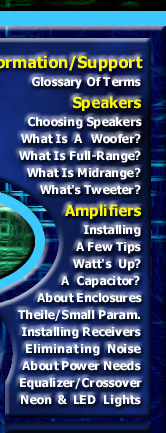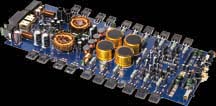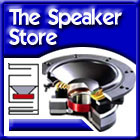




Technical
Help
& Education
Glossary Of Terms
Speakers Main Page
How Speakers Work
Choosing Speakers
What's A Woofer?
What's A Midrange?
What's A Tweeter?
Other Speaker Types
More Speaker Types
What's A Capacitor?
Installing A Capacitor
What's A Crossover?
What's An Equalizer?
Speaker Enclosures
Theile/Small Param.
About Power Amps
Installing An Amp
Installation Tips
Power Ratings
Installing/Replacing
Head Units/Receivers
Installing Neon/LED
Eliminating Noise
Use The Right Tools
Manufacturer's
Links
Personal
& Marine
Electronics
Laptop Computers
Cell Phones & PDAs
Portable TV & Video
Electronic Readers
MP3/Music Players
CD
Players/Booms
Earphones/Buds
Digital Cameras
Video
Cameras
Personal GPS
Bluetooth
Calculators
Accessories
Marine
Electronics
Stereo Amplifiers
Stereo Speakers
Stereo Woofers
Enclosed Speakers
TVS & Video
CD/Mp3 Receivers
GPS & Navigation
Fish Finders
Accessories
Home
Stereo &
Office Electronics
Flat
Screen & HD TVs
Surround Sound
Home Theater
DVD Players/Tivo
DVD Recorders
Blu-Ray Devices
Amplifiers/Tuners
Speaker
Systems
Subwoofer Drivers
Midrange
Drivers
Tweeter Drivers
Powered Subwoofers
Outdoor
Speakers
Stereo Accessories
Digital
Photo Frames
Video Game Systems
Game
Accessories
Video Games
Home Security/Alarms
Computer
Products
Desktops & Laptops
Add-Ons/Peripherals
Computer Monitors
Computer Software
Computer Games
Printers &
Scanners
Ink/Specialty Papers
Parts & Components
Computer Supplies
Security/Tech
Support
Auto
Electronics
Amplifiers
Subwoofers
Full-Range Speakers
Midrange Speakers
Tweeters
Power Capacitors
Empty
Enclosures
Loaded Enclosures
CD/Mp3 Receivers
CD Changers
Bass Packages
Car
TV & Video
Satellite
Radio
Bluetooth Wireless
GPS Navigation
Neon/LED Lighting
Radar Detectors
Chrome
Mufflers
Car Alarms/Security
V
AUTO
PARTS STORE
Auto
Wiring &
Accessories
Air Horns
Power
Antennas
Antenna Boosters
A/V Controllers
Bass Blockers
Crossovers
Dynamat
Equalizers
Fans (Cooling)
FM Modulators
Interfaces
Line Converters
Noise Filters
Power Inverters
Power Supplies
RCA Cables
RCA Splitters
Remote Controls
Signal Boosters
Vibration Control
Speaker Grills
Wiring Kits

Below
is a discussion of amplifiers, what they do, what manufacturers claim
that they do, and what does and does not matter when choosing an amplifier.
Following this discussion is a list of important parameters, tolerances
and definitions including
power
, to take
into consideration when purchasing an amplifier.
If you wish to jump directly to this list,
Click Here
.
Or, for info on
How to install
an Amp
*********************************************
"This
amplifier sounds super smooth, powerful, and yet produces velvetine subtle
details bathed in an atmosphere
of shimmering translucent scintillation."
The
above prose is characteristic of many purported reviews of Audio amplifiers.
It is pure hyperbole that feeds on the kind of marketing-created subjectivism
that infects all too much advertising about audio, and a good many other
products. Remember, science tells the tale best, at least in electronics.
The plain fact of the matter, is that the aim of every high fidelity amplifier
designer is to create a product that has no effect whatsoever on the signal
fed into it, other than to increase its amplitude and prepare it to be
sent to a speaker.
Most of the subjective commentaries on amplifier performance that refer
to such qualities as "warmth," or "precision" are
either the reviewer's impressions of the music, speakers, or listening
environment, or evidence of great deficiencies in the design of the amplifier.
Amplitude
In physics and electronics, amplitude is literally the measurable high
value of a periodically varying quantity. In lay terms, it is the strength
of a signal or sound without regard to its content. Amplitude measurements
of audio signals generally refer to the signal voltage, which is only
one component of what determines power (watts), or the ability to do work.
Thus, it is important to understand that amplitude alone does not singly
determine power (or loudness in audio), but does affect it. In the physical
world the amplitude of a sound is measured in decibels of SPL (sound pressure
level), which again does not wholly define overall sound power or intensity,
only the sound level at one point in time, and one frequency of the audio
spectrum.
Amplifiers
are devices or circuits that increase the amplitude of the signal fed
into them. Any additional changes in the nature of signal are a form of
distortion. A popular engineering aim, is to construct amplifiers as,
" a straight wire with gain." Qualities present in the output
that were not in the input are to be avoided. In the perfect amplifier,
the best thing that could be said of it is that, "It works."
Impedance
Most consumer amplifiers are made to conform to standard expectations
for input and output impedances. Most inputs accept impedance matches
from 47k to 100k ohms, and outputs are rated for 4 ohms (most automotive
speakers), with high power systems capable of 1 ohm loads or smaller.
Most home and pro speakers and amps are rated at 8 ohm loads. There are
a few units that have different ratings to accommodate special purpose
applications, but we need not consider those here.
Distortion
Modern designs and devices inside most amplifiers allow distortion levels
that at 1 percent or less, are essentially imperceptible by a normal human
being when the unit is played at the prescribed parameters and loads.
Thus, Total Harmonic Distortion (THD) and Intermodulation (IM) distortions
have effectively been reduced beyond the threshold of human perception
when played within expected levels. Keep in mind that there are plenty
of other opportunities for distortion to creep into the audio program
at many other points in the chain of reproduction. Microphones, speakers,
and their operating environments are the most common sources of serious
distortion.
Power
But, the real trick for most consumers is to figure out how much power
is required for the specific speaker and application involved.
Loudspeakers have a complex inductive reactance associated with the voice coil and a resistive loading factor that in combination are known as impedance. This impedance varies considerably with frequency. But the standard procedure is to select a nominal value for the purpose of computing the power calculation. For car amplifiers, this is usually four ohms, but with higher power systems this can be much lower. The standard formula multiplies the voltage by the current, or the voltage squared divided by the impedance. The product is the amplifier's power potential in watts.
Note
that amplifiers, like light bulbs only consume watts when they are actually
creating sound in speakers. For this reason, no matter what the capacity
of the amplifier and woofer, normal room volume will, on average, only
need about 5 to 10 watts for sound thought to be loud. The rest of the
extra ten to thousand watts are used only in creating deep loud bass.
An
amplifier's power is dependent on the voltage applied to it and the current
flow it can sustain without breakdown or overheating in the presence of
a normal load. Moreover, these functions must be performed without incurring
any form of perceived distortion. Fortunately, modern electronics makes
it possible to meet these requirements without great expense. For more
on this critical subject, see -
Power
Clipping
Distortion
However the worst form of amplifier malfunction occurs when users try
to make them perform outside of their capacity. The usual symptom is an
item called clipping distortion. This is present when either the amplitude
of the signal being passed is too large, or the impedance load is too
heavy for the rated output capacity. In practical terms, this is the equivalent
of increasing the volume level to the maximum on a very loud sound, or
attaching 10 woofers in parallel on each output terminal. This means that
the most important specification to be observed when choosing an amplifier,
is to make certain that both the usage and the intended load will not
cause the amplifier to go beyond its clipping point.
Peak
Power
Because many people prefer to listen to something other than constant-tone
sine waves, program dynamics play an important role in that they vary
the load on an amplifier from moment to moment. Consequently, most amplifiers
are tolerant of the occasional demand for peak power that goes beyond
its continuous power rating, and in many cases this tolerance can be sustained
for very small periods (microseconds) of time so as to pass sudden burst
energies without objectionable distortion or stress. With bass amplifiers,
you will need to use a capacitor to enable the power supply to keep up,
and prevent damaging clipping.
Probably the best practical advice that can be given to the prospective amplifier buyer is to select speakers appropriate for the usage and space you intend, and then choose an amplifier that can meet those requirements without stress.
A
LIST OF IMPORTANT PARAMETERS, TOLERANCES AND DEFINITIONS TO TAKE INTO
CONSIDERATION WHEN PURCHASING AN AMPLIFIER
However the majority of amplifiers in today's
market will not list all or even most of these figures.
DISTORTION
TOLERANCES
The minimum distortion specifications that will permit an amplifier to
meet high fidelity standards are:
Total
Harmonic Distortion (THD)
At normative load (4 ohms) the THD should be less than 1 percent. (The
lower the number, the less significance it has. 004% is no better in practical
terms, than .1%)
Intermodulation
Distortion (IM)
The IM should be less than 2.5 percent ( the lower the better, but usually
not listed in most current specifications.)
Other Important Measurements And Features
Power Bandwidth
The frequencies for which the full rated power output of the unit can
be applied: at least 20 to 20,000 hertz, the range of human hearing. More
is not necessarily better.
Signal
to Noise ratio (SN)
The ratio of inherent noise produced by the internal components of the
amplifier to the average program material: Min 85 dB (although in a car
environment which is inherently noisy, 55dB would be OK. The higher the
number, the-slightly-better). Howsever, if you have perceptible noise
associated with the engine operation,
check here
Sensitivity
Rating
The sensitivity rating should be at least 230Mv @47k ohms for full output.
Power
Output Ratings
Use the RMS or continuous power ratings instead of the much higher and
much less reliable so-called peak or MAX output specification. In the
absence of an RMS rating, it can be safely estimated that RMS power is
at most 50 percent of the peak power specification. Remember that to double
the loudness in perceived sound, the amplifier must produce 10 the amount
of electrical power in watts. Also, a sound in a car that is subjectively
judged to be really loud can be produced by as little as 10 watts. One
twice as loud would have to use 50 watts, and twice as loud as that, would
require 500 watts. See our section on
Power
Ratings
.
Bridged
Power
This is an arrangement of the amplifier circuit where-in the separate
built-in stereo amplifiers are each given one phase of the unified mono
input signal, which is then recombined to yield an output that is usually
at least twice as high as the individual stereo outputs. Or, 50 watts
stereo would be converted to 100 watts mono.
Built-In
Crossover
There are arrangements on some amplifiers that provide a special switch
allowing the amplifier to respond only to the bass (LPF), or the treble
(HPF), or the full spectrum of the signal. This allows the amp to feed
only the appropriate drivers without an external crossover in the speakers.
It also means that either you will depend on the receiver for the full
range source signals, or you'll have to have more than one amplifier.
Bass
Boost Circuit
A switched circuit that increases the bass response by anywhere from 8
to 20 dB. Be careful though, as this can quickly produce clipping distortion
in some systems.
Mosfet
Output Circuitry
Popular Output devices that produce less heat and greater efficiency in
class AB circuits than older bipolar output transistors. These are now
fairly common in most amplifiers.
Check
our Easy selection System
See
our high power Woofer Selector
Here
.
Once you have selected a woofer or two, go to the amp selector to
Find a Compatible Amplifier
Here
MAIN
PAGE
GLOSSARY
SPEAKERS:
Choosing
General
Woofers
Miidrange
Tweeters
Full-Range
Full-Range 2
CAPACITORS
CROSSOVERS
EQUALIZERS
Theile/Small
AMPLIFIERS:
About
Installing
Install Tips
Power Ratings
RECEIVERS:
Installing
NEON/LED:
Installing
TOOLS
Home
--
Policies
--
Products
--
Tech
Center
--
Auto
Electronics
--
Home
Electronics
--
Personal
& Marine Electronics
--
Stereo
Tech Info
Website Designed & Maintained by
MetroDirect
Communications
Copyright (c) 2000 - 2009
Electronixwarehouse.com
.
Use of any material appearing on this site without specific written
permission is prohibitied by law.
electronixwarehouse.com
---
logobannerfactory.com
---
bleepthem.com (Political Satire)
---
rlebeaux.com
---
stereotechnicalinformation.com (Stereo
Technical Help)
---
electronixwarehouse.net
---
thespeakerstore.com
---
wmpublishing.com (Help For Writers)
---
barbarathenovel.com
---
cutethenovel.com




